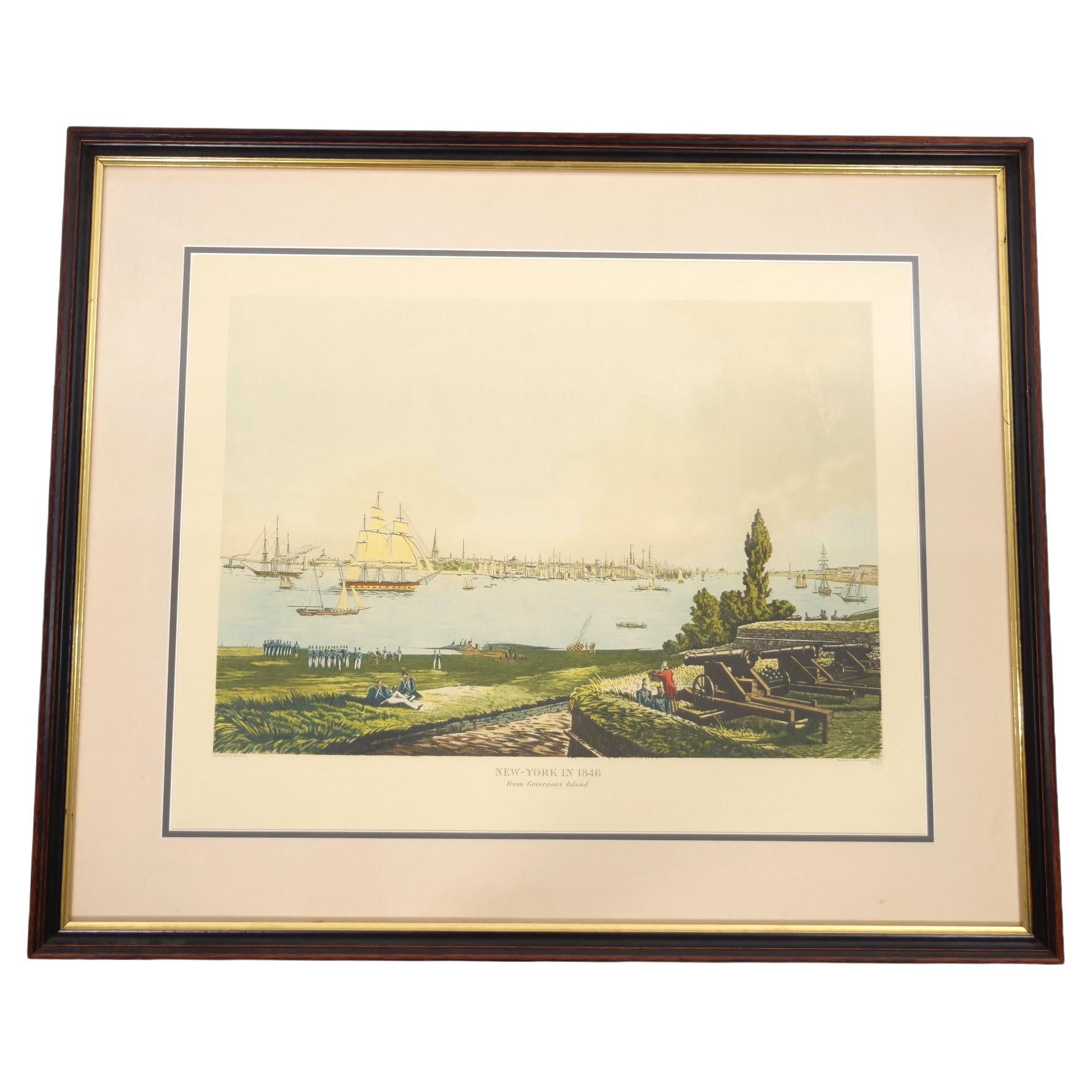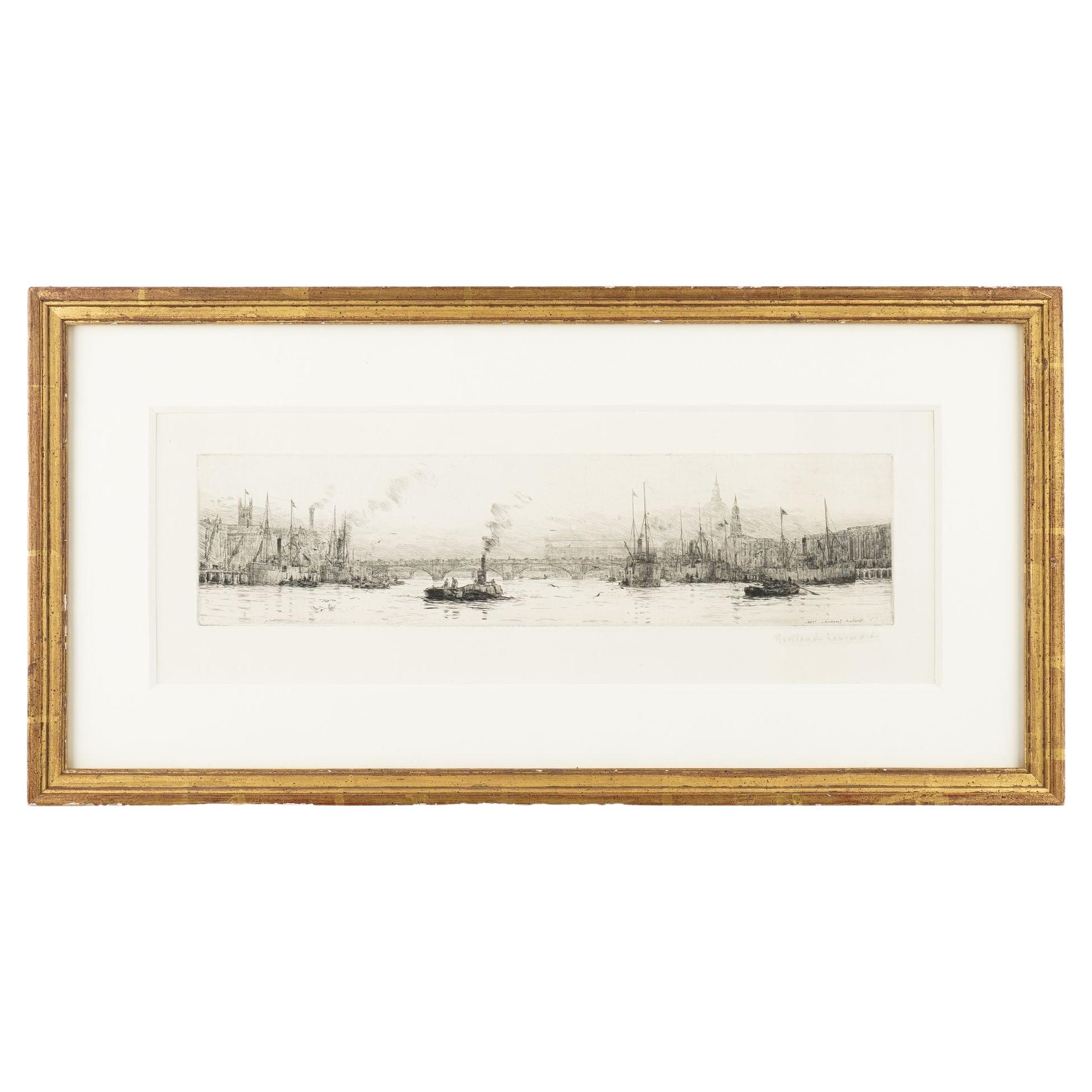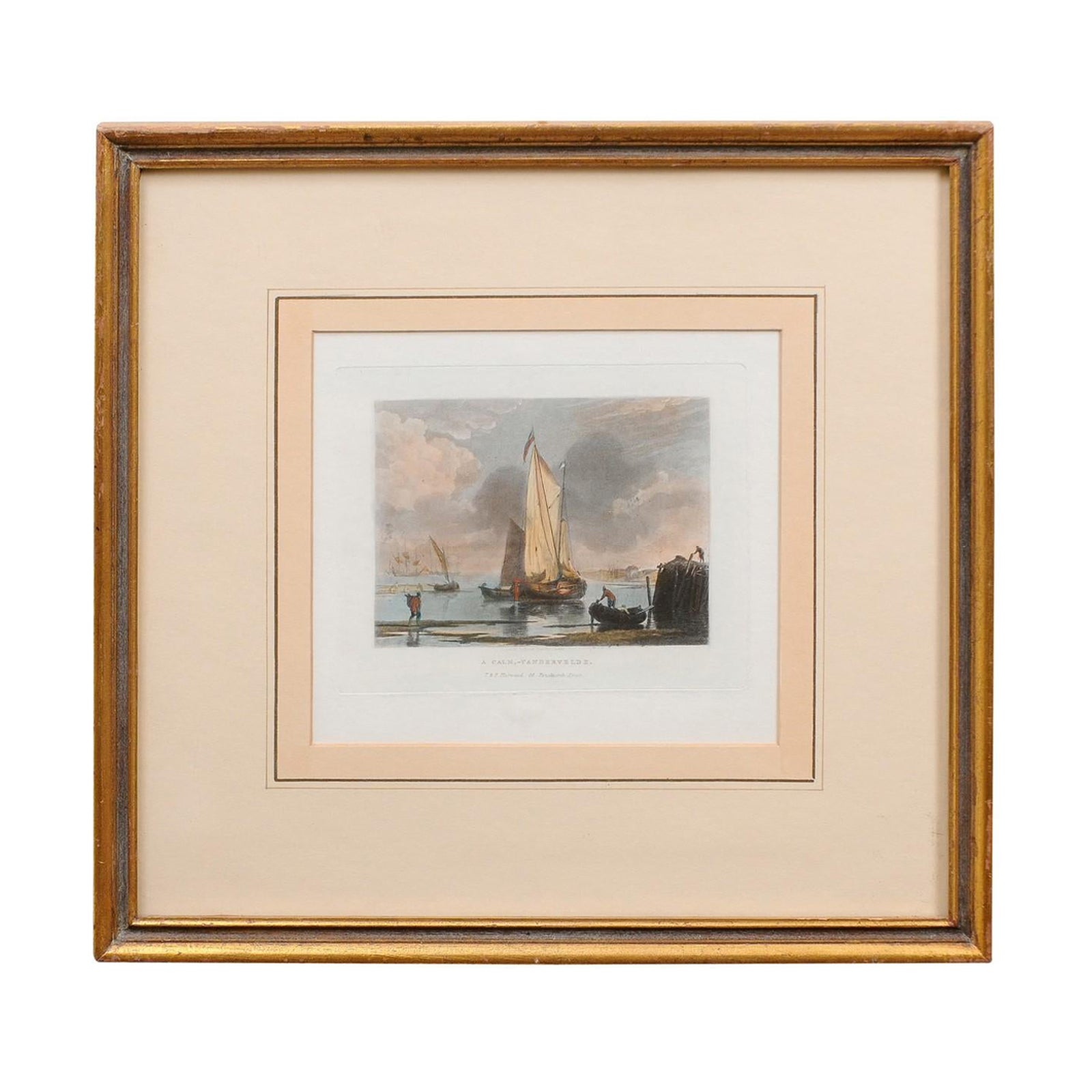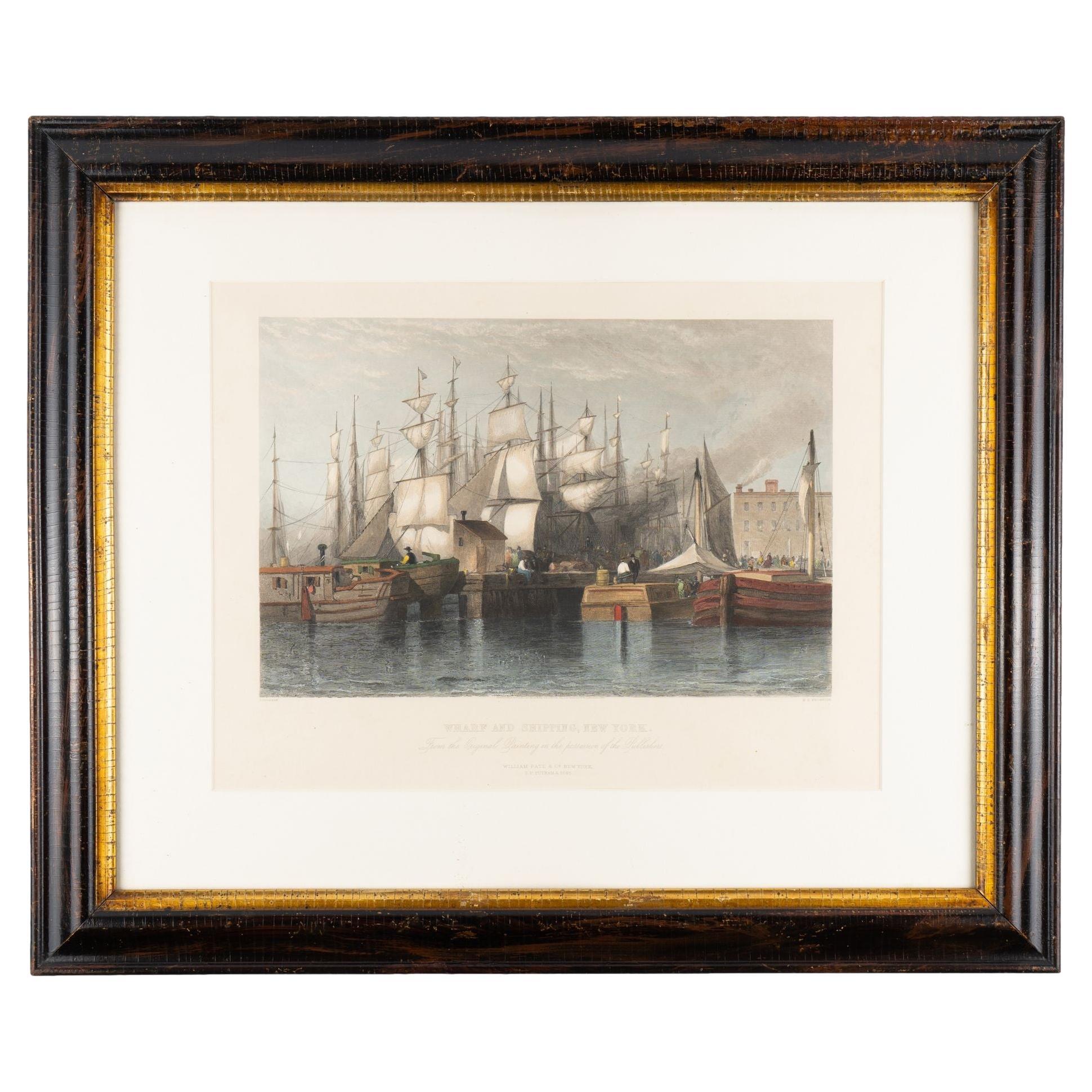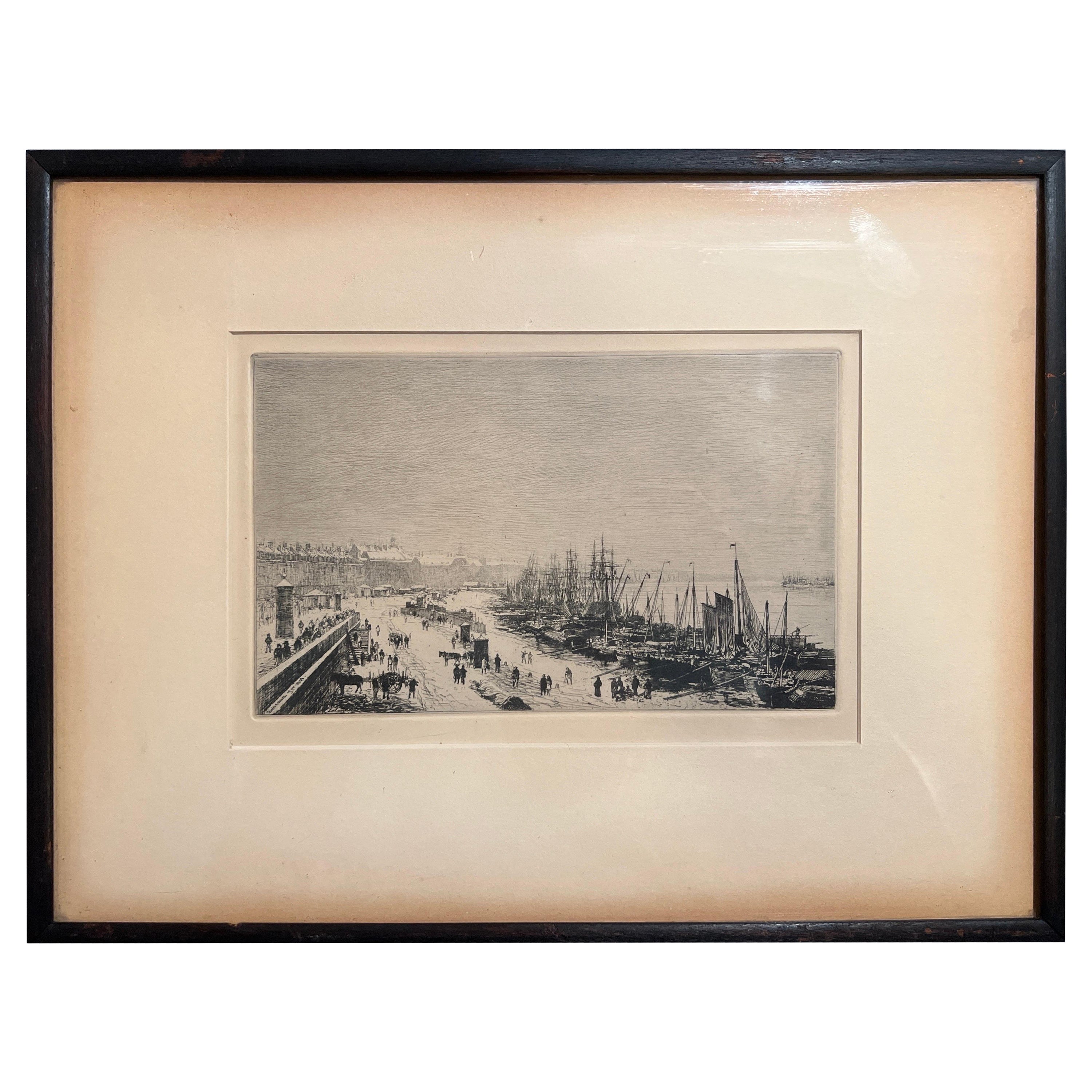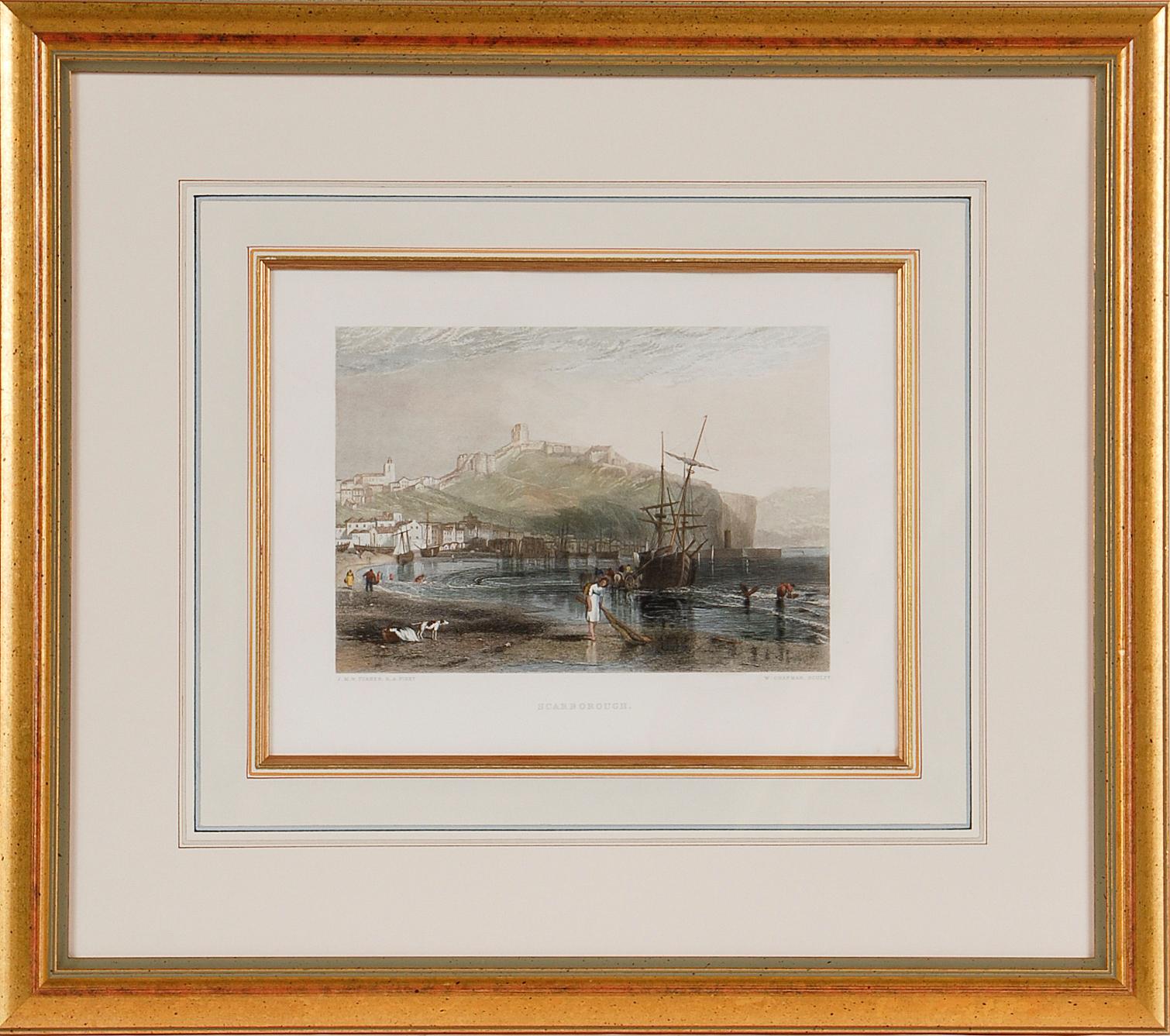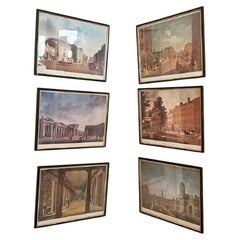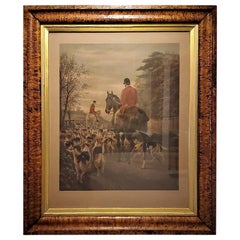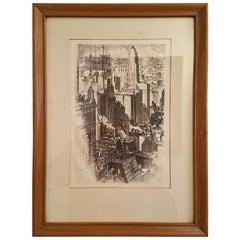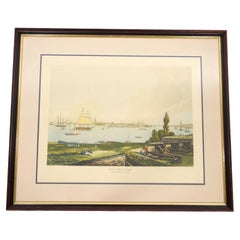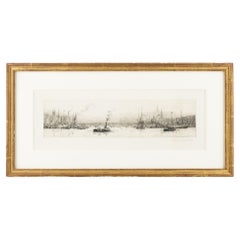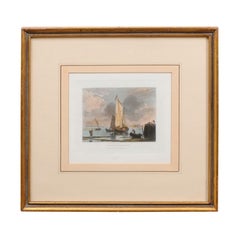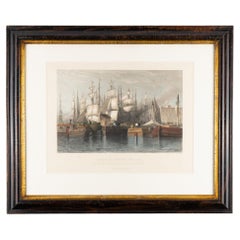Items Similar to 19C Aquatint Engraving of the Quay at Waterford
Want more images or videos?
Request additional images or videos from the seller
1 of 12
19C Aquatint Engraving of the Quay at Waterford
$800
£595.06
€696.70
CA$1,116.27
A$1,249.14
CHF 652.24
MX$15,356.87
NOK 8,228.78
SEK 7,743.24
DKK 5,197.94
Shipping
Retrieving quote...The 1stDibs Promise:
Authenticity Guarantee,
Money-Back Guarantee,
24-Hour Cancellation
About the Item
Presenting a lovely 19C Aquatint Engraving of the Quay at Waterford in Waterford city in Ireland.
This engraving has been hand embellished with aquatint color(s) and is from Ireland circa 1820-40.
It features a scene of the Quay or Port of Waterford from circa 1820. We are basing this upon the attire of the figures in the engraving and the tall ships.
It features Reginald’s Tower (still located at the Waterford Quay to this day). Georgian Quay buildings, a number of moored tall ships and row boats, barrels, horses and carts, women and British soldiers.
The engraving was professionally reframed and matted in Dallas in the 1980’s and the rear of the frame says that it was “Museum Mounted and Matted”. The frame has a lovely Grecian pattern around the front.
If you are Irish, a Waterford Crystal Collector or have your ancestry from Waterford this is a must have !!
This is a very rare engraving !
The name ‘Waterford’ comes from Old Norse Veðrafjorðr ‘ram (wether) fjord‘. The Irish name is Port Láirge, meaning “Lárag’s port”.[6]
Viking raiders first established a settlement near Waterford in 853. It and all the other longphorts were vacated in 902, the Vikings having been driven out by the native Irish. The Vikings re-established themselves in Ireland at Waterford in 914, led at first by Ottir Iarla (Jarl Ottar) until 917, and after that by Ragnall ua Ímair and the Uí Ímair dynasty, and built what would be Ireland’s first city. Among the most prominent rulers of Waterford was Ivar of Waterford.
In 1167, Diarmait Mac Murchada, the deposed King of Leinster, failed in an attempt to take Waterford. He returned in 1170 with Cambro-Norman mercenaries under Richard de Clare, 2nd Earl of Pembroke (known as Strongbow); together they besieged and took the city after a desperate defence. In furtherance of the Norman invasion of Ireland, King Henry II of England landed at Waterford in 1171. Waterford and then Dublin were declared royal cities, with Dublin also declared capital of Ireland.
Throughout the medieval period, Waterford was Ireland’s second city after Dublin. In the 15th century Waterford repelled two pretenders to the English throne: Lambert Simnel and Perkin Warbeck. As a result, King Henry VII gave the city its motto: Urbs Intacta Manet Waterfordia (Waterford remains the untaken city).
After the Protestant Reformation, Waterford remained a Catholic city and participated in the confederation of Kilkenny – an independent Catholic government from 1642 to 1649. This was ended abruptly by Oliver Cromwell, who brought the country back under English rule; his son-in-law Henry Ireton finally took Waterford in 1650 after a major siege.[7] In 1690, during the Williamite War, the Jacobite Irish Army was forced to surrender Waterford in the wake of the Battle of the Boyne.
The 18th century was a period of huge prosperity for Waterford. Most of the city’s best architecture appeared during this time. A permanent military presence was established in the city with the completion of the Cavalry Barracks at the end of the 18th century.[8]
In the early 19th century, Waterford City was deemed vulnerable and the British government erected three Martello towers on the Hook Peninsula to reinforce the existing Fort at Duncannon. During the 19th century, great industries such as glass making and ship building thrived in the city.
The city was represented in the Parliament of the United Kingdom from 1891 to 1918 by John Redmond MP, leader (from January 1900) of the Irish Parliamentary Party. Redmond, then leader of the pro-Parnell faction of the party, defeated David Sheehy in 1891. In 1911, Br. Jerome Foley, Br. Dunstan Drumm and Br. Leopold Loughran left Waterford for Malvern, Australia. Here, they founded a Catholic college which is still in existence today.[9]
In July 1922, Waterford was the scene of fighting between Irish Free State and Irish Republican troops during the Irish Civil War.
- Dimensions:Height: 13.5 in (34.29 cm)Width: 11.5 in (29.21 cm)Depth: 0.75 in (1.91 cm)
- Style:George III (Of the Period)
- Materials and Techniques:Paper,Engraved
- Place of Origin:
- Period:
- Date of Manufacture:1820-1840
- Condition:Wear consistent with age and use. Very good original condition.
- Seller Location:Dallas, TX
- Reference Number:1stDibs: LU3978126152682
About the Seller
4.9
Vetted Professional Seller
Every seller passes strict standards for authenticity and reliability
Established in 2015
1stDibs seller since 2018
389 sales on 1stDibs
Typical response time: 1 hour
- ShippingRetrieving quote...Shipping from: Dallas, TX
- Return Policy
Authenticity Guarantee
In the unlikely event there’s an issue with an item’s authenticity, contact us within 1 year for a full refund. DetailsMoney-Back Guarantee
If your item is not as described, is damaged in transit, or does not arrive, contact us within 7 days for a full refund. Details24-Hour Cancellation
You have a 24-hour grace period in which to reconsider your purchase, with no questions asked.Vetted Professional Sellers
Our world-class sellers must adhere to strict standards for service and quality, maintaining the integrity of our listings.Price-Match Guarantee
If you find that a seller listed the same item for a lower price elsewhere, we’ll match it.Trusted Global Delivery
Our best-in-class carrier network provides specialized shipping options worldwide, including custom delivery.More From This Seller
View AllPair of Venice Etchings by N Erichsen 1904
Located in Dallas, TX
Presenting a lovely pair of Venice etchings by N Erichsen 1904.
This pair of etchings were drawn by N. Erichsen who we understand was a late 19th and early 20th Century English artist.
Both feature scenes from Venice in 1904.
The first one (on the left) is a sketch of the Piazza San MarCo...
Category
Early 20th Century Italian Edwardian Prints
Materials
Paper
$1,200 / set
Set of 6 19C Irish Engraved Prints of Scenes of Dublin by James Malton
Located in Dallas, TX
PRESENTING A FABULOUS AND RARE Set of 6 19C Irish Engraved Prints of Scenes of Dublin by James Malton.
Set of 6 VERY RARE AND VALUABLE engraved prints of Dublin, Ireland scenes.
These were printed by ‘Cahill Printers Ltd.’ circa 1880-1900.
‘Cahill Printers Ltd’ have been in existence since 1866 and acquired the rights to print these copies of the original watercolors by James Malton (1761 – 1803).
Set of 6 19C Irish Engraved Prints of Scenes of Dublin by James Malton
These scenes are: (in order):
Rotunda & New Rooms,
Great Court Yard Dublin Castle...
Category
Antique Late 19th Century Irish George II Prints
Materials
Wood, Paper
19th Century EAS Douglas Hunt Scene Aquatint Engraving
Located in Dallas, TX
Presenting a lovely late 19th century, EAS Douglas hunt scene aquatint engraving.
Hand colored and originally painted by Edward Algernon Stuart Douglas (1...
Category
Antique Late 19th Century English Victorian Prints
Materials
Paper
Original Etching by AC Webb of Chicago Skyline in 1930
Located in Dallas, TX
Presenting a very rare original etching by Alonzo C. Webb of the City of Chicago with a view of Downtown from 1930.
This etching is in superb original condition.
It is an origi...
Category
Early 20th Century American Art Deco Drawings
Materials
Parchment Paper
19C Engraving of Lake Gaube in the Pyrenees by T Allom
By Thomas Allom
Located in Dallas, TX
Presenting a lovely 19C engraving of Lake Gaube in the Pyrenees by T Allom.
From circa 1850.
Besautiful depiction of Lake Gaube or Lac de Gaube in the F...
Category
Antique Mid-19th Century French Victorian Prints
Materials
Paper
Original Etching by AC Webb Paris of Mather Tower Chicago
Located in Dallas, TX
Presenting a very rare original etching by Alonzo C. Webb of the City of Chicago with a view of Downtown from circa 1930.
A visual and historic recording of 'the Windy City's' his...
Category
Early 20th Century American Art Deco Drawings
Materials
Parchment Paper
You May Also Like
New York / 1846 Framed Aquatint Etching After Frederick Caitherwood
Located in Tarry Town, NY
Step into the past with this captivating aquatint print titled "New York in 1846 from Governors Island," a faithful copy of the original sketch by the renowned artist Frederick Caith...
Category
Early 20th Century American Prints
Materials
Paper
Engraving of London from the Docklands by Rowland Langmaid, 1926
Located in Kenilworth, IL
Widescreen copperplate engraving of London on the Thames River from the Docklands.
English, 1926.
Dimensions: 20-1/4” W x 10-1/8” H x 3/4" D (framed)
Category
Vintage 1920s British Prints
Materials
Paper
Framed 19th Century Engraving of Sailboat, London
Located in Atlanta, GA
Framed 19th Century Engraving of Sailboat, London
Category
Antique 19th Century English Decorative Art
Materials
Paper
Wharf and Shipping, New York by H.S. Beckwith, 1869
Located in Kenilworth, IL
Hand colored print of New York harbor by H. S. Beckwith after S. Coleman. Labeled under the work is "Wharf and Shipping, New York. From the Original Painting in the possession of the...
Category
Antique 1860s American Prints
Materials
Paper
Maxime Lalanne "Rade de Bordeaux" original etching C. 1868
Located in Atlanta, GA
This is a mid 19th century etching entitled "Rade de Bordeaux, Janvier" (Port Of Bordeaux In Winter), Maxime Lalanne in London in 1868. The etching depicts many boats in the busy harbor of Bordeaux, including small sailboats, as well as tall ships. Another harbor is seen in the distance across the river on the left. Snow covered buildings are on the left and extending long distances in the distant background. Many people occupy the road and ground centrally and on the left along with some horses or mules attached to carts. The sky is a wintery gray.
It is signed in the plate in the lower left, the title and date are in the center and Bordeaux and the year are included in script along the top of a wall in the lower left of the engraving. This etching is held by many museums and institutions, including The National Gallery of Art, Washington, D.C.
François Antoine Maxime Lalanne (1827-1886) was a leading French etcher and painter of landscapes and urban views, who was at the forefront of the French revival of etching during the 1860's. He grew up in Bordeaux, but he refined his artistic skills and worked in Paris. His art was first exhibited at the Paris Salon in 1852 and he continued to regularly show both etchings and paintings there until the mid 1880's. He was also the author of several important books on the subjects of etching and other graphic arts. He was a founding member of the Societe des Aquafortistes, along with Auguste Delatre, Cadart, Ribot and Bracquemond. Lalanne created over one hundred and fifty fine etchings. Lalanne's unique style of art influenced many French and English artists in the twentieth century.
Philip Gilbert Hamerton (1834-1894) was a British artist, art critic and author. He was particularly focussed on contemporary graphic art and printmaking techniques. He frequently wrote about the theory of the English Etching Revival, contributing to the establishment of etching as an original and major art medium. He was the editor of The Portfolio (1870-1893), a major arts publication dealing extensively with the art of etching. His most influential book was "Etching and Etchers", which detailed the creative and technical aspects of etching and engraving. The first edition was published in 1868 and included original etchings by Jongkind, Haden and Palmer, as well later states of 17th century Dutch masters. He published a second edition in 1876 without any original etchings. A third edition was published in 1880 in a large paper edition, limited to one thousand copies, which included twenty original etchings from contemporary artists Whistler, Haden, Palmer, Israels, Jacque, Jacquemart, Lalanne, Appian, Legros, Herkomer. including this original Lalanne etching...
Category
Antique 19th Century French Prints
Materials
Paper
$476 Sale Price
20% Off
A View of Scarborough, England: A Framed 19th C. Engraving After J. M. W. Turner
By J.M.W. Turner
Located in Alamo, CA
This beautiful 19th century framed engraving "Scarborough" by W. Chapman is based on an original painting by the renowned British artist J.M.W. Turner. It was published in London by ...
Category
Mid-19th Century Romantic Landscape Prints
Materials
Engraving
